Jiaman Wu
Mind2Web 2: Evaluating Agentic Search with Agent-as-a-Judge
Jun 26, 2025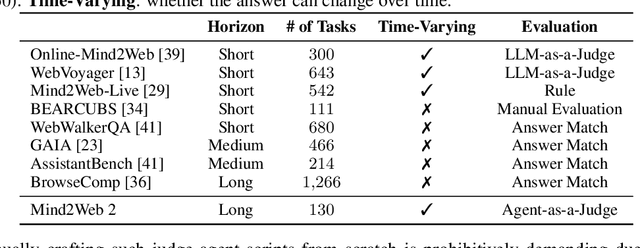

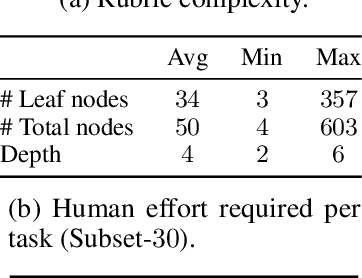
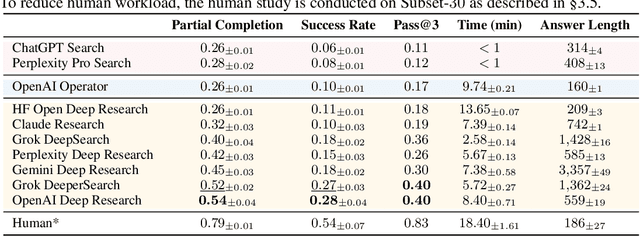
Abstract:Agentic search such as Deep Research systems, where large language models autonomously browse the web, synthesize information, and return comprehensive citation-backed answers, represents a major shift in how users interact with web-scale information. While promising greater efficiency and cognitive offloading, the growing complexity and open-endedness of agentic search have outpaced existing evaluation benchmarks and methodologies, which largely assume short search horizons and static answers. In this paper, we introduce Mind2Web 2, a benchmark of 130 realistic, high-quality, and long-horizon tasks that require real-time web browsing and extensive information synthesis, constructed with over 1,000 hours of human labor. To address the challenge of evaluating time-varying and complex answers, we propose a novel Agent-as-a-Judge framework. Our method constructs task-specific judge agents based on a tree-structured rubric design to automatically assess both answer correctness and source attribution. We conduct a comprehensive evaluation of nine frontier agentic search systems and human performance, along with a detailed error analysis to draw insights for future development. The best-performing system, OpenAI Deep Research, can already achieve 50-70% of human performance while spending half the time, showing a great potential. Altogether, Mind2Web 2 provides a rigorous foundation for developing and benchmarking the next generation of agentic search systems.
BioCLIP 2: Emergent Properties from Scaling Hierarchical Contrastive Learning
May 29, 2025Abstract:Foundation models trained at scale exhibit remarkable emergent behaviors, learning new capabilities beyond their initial training objectives. We find such emergent behaviors in biological vision models via large-scale contrastive vision-language training. To achieve this, we first curate TreeOfLife-200M, comprising 214 million images of living organisms, the largest and most diverse biological organism image dataset to date. We then train BioCLIP 2 on TreeOfLife-200M to distinguish different species. Despite the narrow training objective, BioCLIP 2 yields extraordinary accuracy when applied to various biological visual tasks such as habitat classification and trait prediction. We identify emergent properties in the learned embedding space of BioCLIP 2. At the inter-species level, the embedding distribution of different species aligns closely with functional and ecological meanings (e.g., beak sizes and habitats). At the intra-species level, instead of being diminished, the intra-species variations (e.g., life stages and sexes) are preserved and better separated in subspaces orthogonal to inter-species distinctions. We provide formal proof and analyses to explain why hierarchical supervision and contrastive objectives encourage these emergent properties. Crucially, our results reveal that these properties become increasingly significant with larger-scale training data, leading to a biologically meaningful embedding space.
Building Machine Learning Challenges for Anomaly Detection in Science
Mar 03, 2025Abstract:Scientific discoveries are often made by finding a pattern or object that was not predicted by the known rules of science. Oftentimes, these anomalous events or objects that do not conform to the norms are an indication that the rules of science governing the data are incomplete, and something new needs to be present to explain these unexpected outliers. The challenge of finding anomalies can be confounding since it requires codifying a complete knowledge of the known scientific behaviors and then projecting these known behaviors on the data to look for deviations. When utilizing machine learning, this presents a particular challenge since we require that the model not only understands scientific data perfectly but also recognizes when the data is inconsistent and out of the scope of its trained behavior. In this paper, we present three datasets aimed at developing machine learning-based anomaly detection for disparate scientific domains covering astrophysics, genomics, and polar science. We present the different datasets along with a scheme to make machine learning challenges around the three datasets findable, accessible, interoperable, and reusable (FAIR). Furthermore, we present an approach that generalizes to future machine learning challenges, enabling the possibility of large, more compute-intensive challenges that can ultimately lead to scientific discovery.
BioCLIP: A Vision Foundation Model for the Tree of Life
Dec 04, 2023Abstract:Images of the natural world, collected by a variety of cameras, from drones to individual phones, are increasingly abundant sources of biological information. There is an explosion of computational methods and tools, particularly computer vision, for extracting biologically relevant information from images for science and conservation. Yet most of these are bespoke approaches designed for a specific task and are not easily adaptable or extendable to new questions, contexts, and datasets. A vision model for general organismal biology questions on images is of timely need. To approach this, we curate and release TreeOfLife-10M, the largest and most diverse ML-ready dataset of biology images. We then develop BioCLIP, a foundation model for the tree of life, leveraging the unique properties of biology captured by TreeOfLife-10M, namely the abundance and variety of images of plants, animals, and fungi, together with the availability of rich structured biological knowledge. We rigorously benchmark our approach on diverse fine-grained biology classification tasks, and find that BioCLIP consistently and substantially outperforms existing baselines (by 17% to 20% absolute). Intrinsic evaluation reveals that BioCLIP has learned a hierarchical representation conforming to the tree of life, shedding light on its strong generalizability. Our code, models and data will be made available at https://github.com/Imageomics/bioclip.
LLM-Planner: Few-Shot Grounded Planning for Embodied Agents with Large Language Models
Dec 08, 2022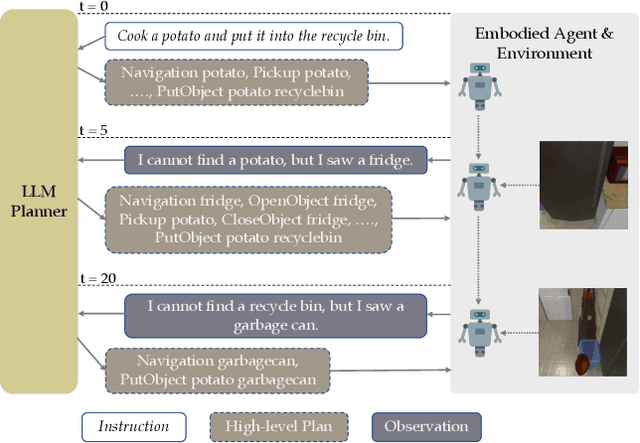
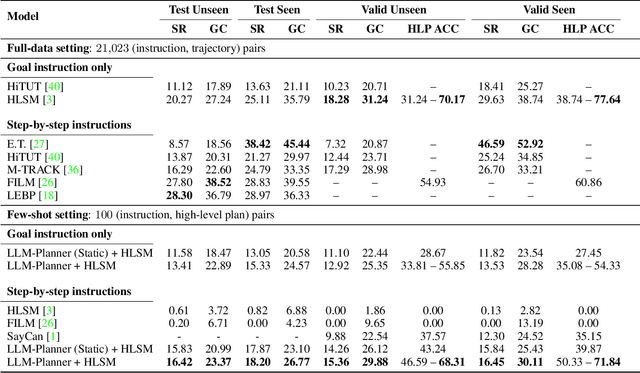
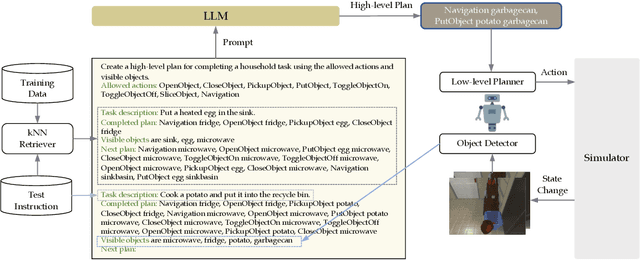
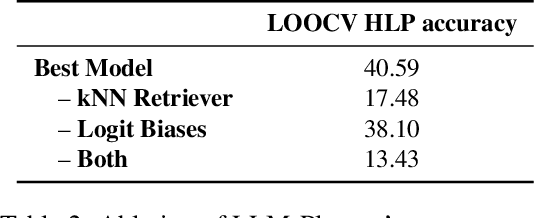
Abstract:This study focuses on embodied agents that can follow natural language instructions to complete complex tasks in a visually-perceived environment. Existing methods rely on a large amount of (instruction, gold trajectory) pairs to learn a good policy. The high data cost and poor sample efficiency prevents the development of versatile agents that are capable of many tasks and can learn new tasks quickly. In this work, we propose a novel method, LLM-Planner, that harnesses the power of large language models (LLMs) such as GPT-3 to do few-shot planning for embodied agents. We further propose a simple but effective way to enhance LLMs with physical grounding to generate plans that are grounded in the current environment. Experiments on the ALFRED dataset show that our method can achieve very competitive few-shot performance, even outperforming several recent baselines that are trained using the full training data despite using less than 0.5% of paired training data. Existing methods can barely complete any task successfully under the same few-shot setting. Our work opens the door for developing versatile and sample-efficient embodied agents that can quickly learn many tasks.
A Slot Is Not Built in One Utterance: Spoken Language Dialogs with Sub-Slots
Mar 21, 2022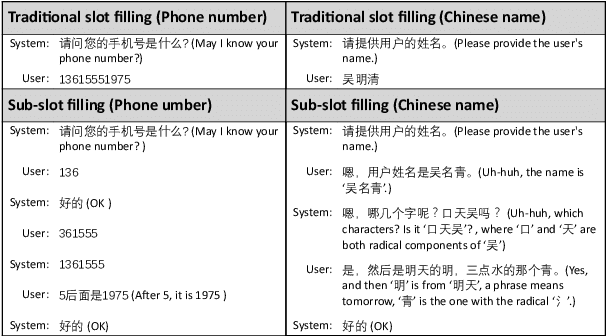

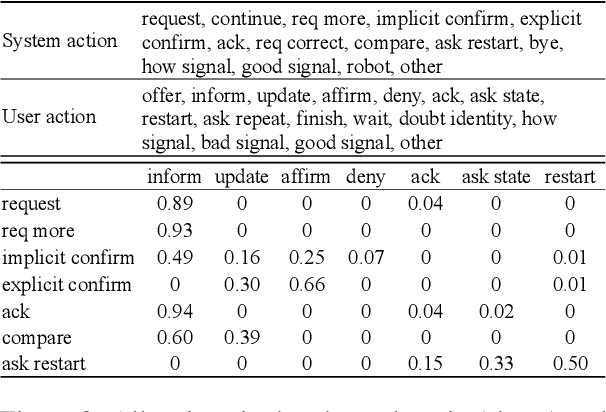

Abstract:A slot value might be provided segment by segment over multiple-turn interactions in a dialog, especially for some important information such as phone numbers and names. It is a common phenomenon in daily life, but little attention has been paid to it in previous work. To fill the gap, this paper defines a new task named Sub-Slot based Task-Oriented Dialog (SSTOD) and builds a Chinese dialog dataset SSD for boosting research on SSTOD. The dataset includes a total of 40K dialogs and 500K utterances from four different domains: Chinese names, phone numbers, ID numbers and license plate numbers. The data is well annotated with sub-slot values, slot values, dialog states and actions. We find some new linguistic phenomena and interactive manners in SSTOD which raise critical challenges of building dialog agents for the task. We test three state-of-the-art dialog models on SSTOD and find they cannot handle the task well on any of the four domains. We also investigate an improved model by involving slot knowledge in a plug-in manner. More work should be done to meet the new challenges raised from SSTOD which widely exists in real-life applications. The dataset and code are publicly available via https://github.com/shunjiu/SSTOD.
Sensei: Self-Supervised Sensor Name Segmentation
Jan 01, 2021


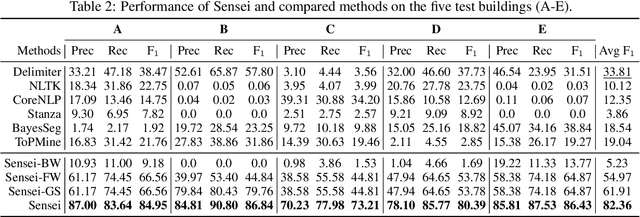
Abstract:A sensor name, typically an alphanumeric string, encodes the key context (e.g., function and location) of a sensor needed for deploying smart building applications. Sensor names, however, are curated in a building vendor-specific manner using different structures and vocabularies that are often esoteric. They thus require tremendous manual effort to annotate on a per-building basis; even to just segment these sensor names into meaningful chunks. In this paper, we propose a fully automated self-supervised framework, Sensei, which can learn to segment sensor names without any human annotation. Specifically, we employ a neural language model to capture the underlying sensor naming structure and then induce self-supervision based on information from the language model to build the segmentation model. Extensive experiments on five real-world buildings comprising thousands of sensors demonstrate the superiority of Sensei over baseline methods.
RoNGBa: A Robustly Optimized Natural Gradient Boosting Training Approach with Leaf Number Clipping
Dec 05, 2019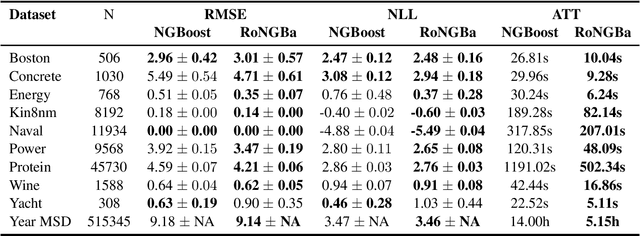
Abstract:Natural gradient has been recently introduced to the field of boosting to enable the generic probabilistic predication capability. Natural gradient boosting shows promising performance improvements on small datasets due to better training dynamics, but it suffers from slow training speed overhead especially for large datasets. We present a replication study of NGBoost(Duan et al., 2019) training that carefully examines the impacts of key hyper-parameters under the circumstance of best-first decision tree learning. We find that with the regularization of leaf number clipping, the performance of NGBoost can be largely improved via a better choice of hyperparameters. Experiments show that our approach significantly beats the state-of-the-art performance on various kinds of datasets from the UCI Machine Learning Repository while still has up to 4.85x speed up compared with the original approach of NGBoost.
A Data-driven Storage Control Framework for Dynamic Pricing
Dec 01, 2019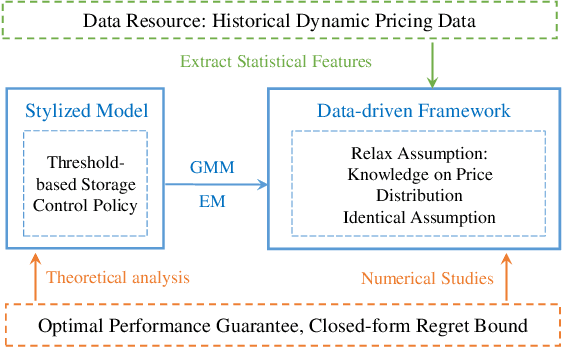
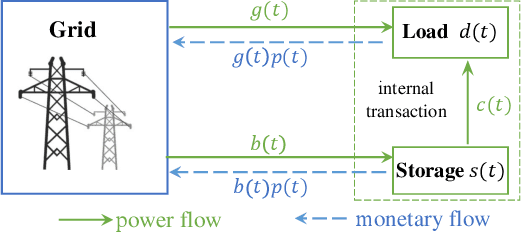
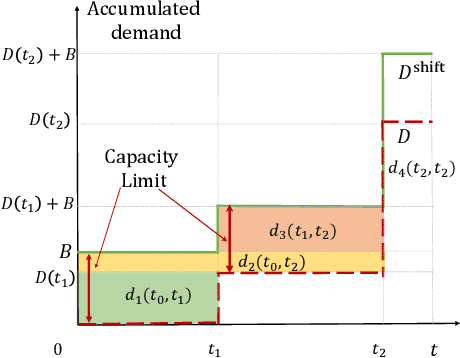
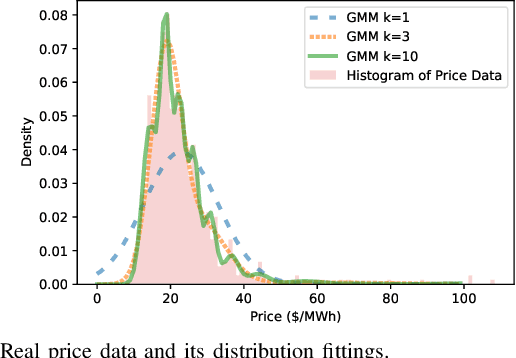
Abstract:Dynamic pricing is both an opportunity and a challenge to the demand side. It is an opportunity as it better reflects the real time market conditions and hence enables an active demand side. However, demand's active participation does not necessarily lead to benefits. The challenge conventionally comes from the limited flexible resources and limited intelligent devices in demand side. The decreasing cost of storage system and the widely deployed smart meters inspire us to design a data-driven storage control framework for dynamic prices. We first establish a stylized model by assuming the knowledge and structure of dynamic price distributions, and design the optimal storage control policy. Based on Gaussian Mixture Model, we propose a practical data-driven control framework, which helps relax the assumptions in the stylized model. Numerical studies illustrate the remarkable performance of the proposed data-driven framework.
 Add to Chrome
Add to Chrome Add to Firefox
Add to Firefox Add to Edge
Add to Edge